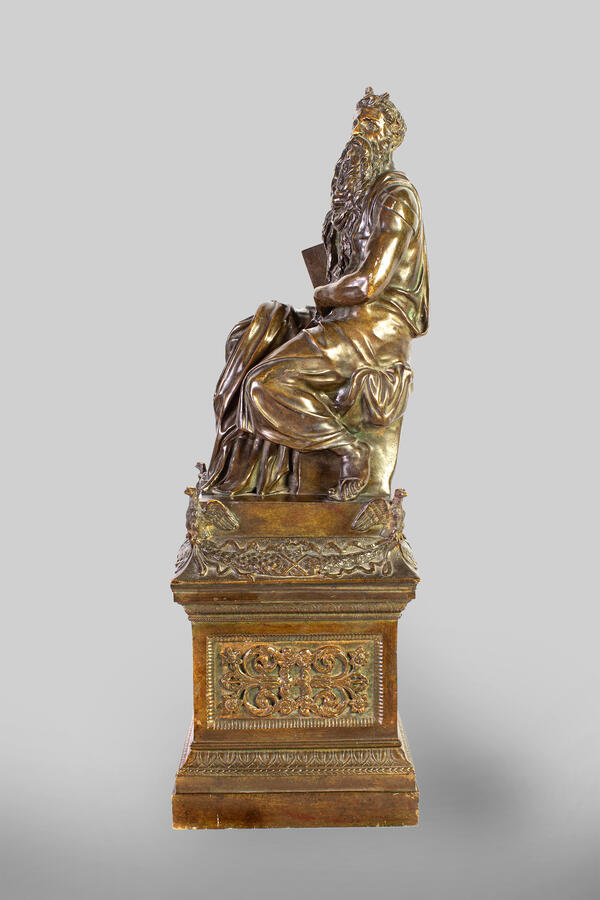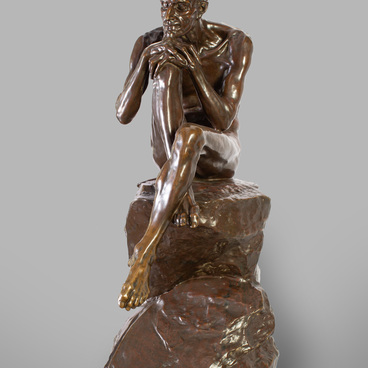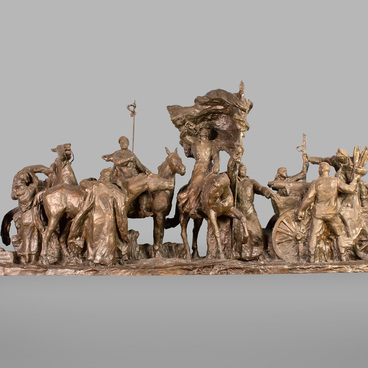The Tambov Art Gallery houses a smaller-sized copy of the statue “Moses” by Michelangelo Buonarroti, created for the tomb of Pope Julius II. The original marble statue of the Old Testament prophet is located in its historic place — in the church San Pietro in Vincoli, Rome.
Michelangelo Buonarroti (1475–1564) was an outstanding sculptor, painter, architect, poet, and master of the Renaissance. He studied under the painter Ridolfo Ghirlandaio and the sculptor Bertoldo di Giovanni. Michelangelo worked in Florence and Rome. He created indoor and monumental sculptures, paintings, and murals. He also participated in the construction of architectural ensembles.
It is known that Michelangelo worked on the sculpture “Moses” between 1513 and 1515. The great artist created the image of a mighty old man, prophet, and leader of the Jewish people, who led the Exodus of the Israelites out of Egypt to the Promised Land. The idea of the sculpture is an allegory, used to express the historical mission that Pope Julius II strove to fulfill by leading the struggle for the national liberation and unification of Italy.
As a rule, Moses was depicted as an old man with a gray patriarchal beard. He holds the tablets in his hands. Moses received those from God with the commandments that the people had to live by. Having descended from the mountain, he saw that while he was gone, the people went against one of the commandments and were worshiping a golden idol. Enraged, Moses destroyed the idol and ordered the warriors to slay the sinners. The face of Moses emits radiance, which was usually depicted as rays of light resembling two horns. The prophet is depicted with horns due to the incorrect Vulgate translation of several lines in the biblical book “Exodus”. The Hebrew text says that it was difficult for the Israelites to look into the face of Moses, כי קרן עור פניו (ki karan ohr pnav). However, the word “qarnayim” (קרניים) has several meanings in Hebrew, and it can be translated both as “horns” and “rays”. Therefore, the phrase כי קרן עור פניו should be translated as “because the skin of his face radiated [beamed]” instead of “because his face was horned.”
The sculpture “Moses” was transferred to the Tambov Art Gallery from the Tambov Museum of Local Lore. The work of art used to be part of Pavel Sergeyevich Stroganov’s private collection, which was housed in his estate Znamenka, Tambov Governorate. Another similar-looking copy can be found in the Morshansk History and Art Museum.
Michelangelo Buonarroti (1475–1564) was an outstanding sculptor, painter, architect, poet, and master of the Renaissance. He studied under the painter Ridolfo Ghirlandaio and the sculptor Bertoldo di Giovanni. Michelangelo worked in Florence and Rome. He created indoor and monumental sculptures, paintings, and murals. He also participated in the construction of architectural ensembles.
It is known that Michelangelo worked on the sculpture “Moses” between 1513 and 1515. The great artist created the image of a mighty old man, prophet, and leader of the Jewish people, who led the Exodus of the Israelites out of Egypt to the Promised Land. The idea of the sculpture is an allegory, used to express the historical mission that Pope Julius II strove to fulfill by leading the struggle for the national liberation and unification of Italy.
As a rule, Moses was depicted as an old man with a gray patriarchal beard. He holds the tablets in his hands. Moses received those from God with the commandments that the people had to live by. Having descended from the mountain, he saw that while he was gone, the people went against one of the commandments and were worshiping a golden idol. Enraged, Moses destroyed the idol and ordered the warriors to slay the sinners. The face of Moses emits radiance, which was usually depicted as rays of light resembling two horns. The prophet is depicted with horns due to the incorrect Vulgate translation of several lines in the biblical book “Exodus”. The Hebrew text says that it was difficult for the Israelites to look into the face of Moses, כי קרן עור פניו (ki karan ohr pnav). However, the word “qarnayim” (קרניים) has several meanings in Hebrew, and it can be translated both as “horns” and “rays”. Therefore, the phrase כי קרן עור פניו should be translated as “because the skin of his face radiated [beamed]” instead of “because his face was horned.”
The sculpture “Moses” was transferred to the Tambov Art Gallery from the Tambov Museum of Local Lore. The work of art used to be part of Pavel Sergeyevich Stroganov’s private collection, which was housed in his estate Znamenka, Tambov Governorate. Another similar-looking copy can be found in the Morshansk History and Art Museum.






